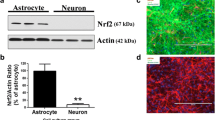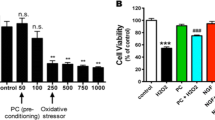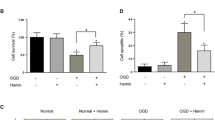Abstract
The protective effect of astrocytes on nerves was demonstrated by mitochondrial transfer. The neuroprotective effect of hypoxic pretreatment is widely accepted. The aim of this research is to investigate the role of hypoxic preconditioning on astrocytes mitochondria. Rat neuronal cells and astrocytes were isolated and cultured. A hypoxic preconditioned astrocyte and oxygen glucose deprivation (OGD) neuronal cell co-culture experiment was used to detect the effect of hypoxic preconditioning (HP) on nerve damage. The silencing of proliferator-activated receptor γ coactivator-1α (PGC-1α) with siRNA was used to explore the role of HP in the repair of nerve damage and biogenesis of mitochondria. HP increased astrocyte viability and promoted neuroprotective factor secretion. The expression levels of antioxidant enzymes, PGC-1α and uncoupling protein2 (UCP2) were up-regulated by HP. In addition, HP improved mitochondrial function and reduced oxidative stress induced by OGD. It was found that HP astrocytes had a greater neuroprotective effect than normal astrocytes cells. Neuronal apoptosis and reactive oxygen species levels were down-regulated by cell co-culture. The PGC-1α siRNA experiment showed that hypoxia treatment promotes mitochondrial biogenesis and plays a neuroprotective role. HP significantly enhanced the efficacy of astrocytes in the treatment of neuronal injury.




Similar content being viewed by others
References
Chuang YC, Chen SD, Jou SB, Lin TK, Chen SF, Chen NC and Hsu CY 2019 Sirtuin 1 regulates mitochondrial biogenesis and provides an endogenous neuroprotective mechanism against seizure-induced neuronal cell death in the hippocampus following status epilepticus. Int. J. Mol. Sci. 14 20
Civita P, Leite MD and Pilkington GJ 2019 Pre-clinical drug testing in 2D and 3D human in vitro models of glioblastoma incorporating non-neoplastic astrocytes: tunneling nano tubules and mitochondrial transfer modulates cell behavior and therapeutic respons. Int. J. Mol. Sci. 23 20
English K, Shepherd A, Uzor NE, Trinh R, Kavelaars A and Heijnen CJ 2020 Astrocytes rescue neuronal health after cisplatin treatment through mitochondrial transfer. Acta Neuropathol. Commun. 8 36
Gerster T, Lun K, Brand M and Busslinger M 1998 Characterization of three novel members of the zebrafish Pax2/5/8 family: dependency of Pax5 and Pax8 expression on the Pax2.1 (noi) function. Development 125 3063–3074
Gollihue JL and Norris CM 2020 Astrocyte mitochondria: Central players and potential therapeutic targets for neurodegenerative diseases and injury. Age. Res. Rev. 59 101039
Gu S, Hua H, Guo X, Jia Z, Zhang Y, Maslov LN, Zhang X and Ma H 2018 PGC-1α Participates in the protective effect of chronic intermittent hypobaric hypoxia on Cardiomyocytes. Cell. Physiol. Biochem. Int. J. Exp. Cell. Physiol. Biochem. Pharmacol. 50 1891–1902
Guo M, Ma X, Feng Y, Han S, Dong Q, Cui M and Zhao Y 2019 In chronic hypoxia, glucose availability and hypoxic severity dictate the balance between HIF-1 and HIF-2 in astrocytes. FASEB J. 33 11123–11136
Huang L, Reis C, Boling WW and Zhang JH 2020 Stem cell therapy in brain ischemia: the role of mitochondrial transfer. Stem Cells Dev. 29 555–561
Huang L, Wu S, Li H, Dang Z and Wu Y 2019 Hypoxic preconditioning relieved ischemic cerebral injury by promoting immunomodulation and microglia polarization after middle cerebral artery occlusion in rats. Brain Res. 1723 146388
Jia L, Wang J, Cao H, Zhang X, Rong W and Xu Z 2020 Activation of PGC-1α and mitochondrial biogenesis protects against prenatal hypoxic-ischemic brain injury. Neuroscience 432 63–72
Jung JE, Sun G, Bautista Garrido J, Obertas L, Mobley AS, Ting SM, Zhao X and Aronowski J 2020 The mitochondria-derived peptide humanin improves recovery from intracerebral hemorrhage: implication of mitochondria transfer and microglia phenotype change. J. Neurosci. 40 2154–2165
Kang C and LL Ji 2016 PGC-1α overexpression via local transfection attenuates mitophagy pathway in muscle disuse atrophy. Free Rad. Biol. Med. 93 32–40
Lai Y, Lin P, Chen M, Zhang Y, Chen J, Zheng M, Liu J, Du H, Chen R, Pan X, Liu N and Chen H 2020 Restoration of L-OPA1 alleviates acute ischemic stroke injury in rats via inhibiting neuronal apoptosis and preserving mitochondrial function. Redox Biol. 34 101503
Liu Z and Chopp M 2016 Astrocytes, therapeutic targets for neuroprotection and neurorestoration in ischemic stroke. Progress Neurobiol. 144 103–120
Peng L, Zhao Y, Li Y, Zhou Y, Li L, Lei S, Yu S and Zhao Y 2019 Effect of DJ-1 on the neuroprotection of astrocytes subjected to cerebral ischemia/reperfusion injury. J. mol. Med. 97 189–199
Selvakumar GP, Iyer SS, Kempuraj D, Raju M, Thangavel R, Saeed D, Ahmed ME, Zahoor H, Raikwar SP, Zaheer S and A Zaheer 2018 Glia maturation factor dependent inhibition of mitochondrial pgc-1α triggers oxidative stress-mediated apoptosis in n27 rat dopaminergic neuronal cells. Mol. Neurobiol. 55 7132–7152
Sen E, Basu A, Willing LB, Uliasz TF, Myrkalo JL, Vannucci SJ, Hewett SJ and SW Levison 2011 Pre-conditioning induces the precocious differentiation of neonatal astrocytes to enhance their neuroprotective properties. ASN Neuro. 3 e00062
Sidoryk-Wegrzynowicz M, Gerber YN, Ries M, Sastre M, Tolkovsky AM and Spillantini MG 2017 Astrocytes in mouse models of tauopathies acquire early deficits and lose neurosupportive functions. Acta Neuropathol. Commun. 5 89
Stepanova A, Kahl A, Konrad C, Ten V, Starkov AS and Galkin A 2017 Reverse electron transfer results in a loss of flavin from mitochondrial complex I: Potential mechanism for brain ischemia reperfusion injury. J. Cerebral Blood Flow Metab. 37 3649–3658
Wang Y, Nartiss Y, Steipe B, McQuibban GA and Kim PK 2012 ROS-induced mitochondrial depolarization initiates PARK2/PARKIN-dependent mitochondrial degradation by autophagy. Autophagy 8 1462–1476
Xiong H, Chen S, Lai L, Yang H, Xu Y, Pang J, Su Z, Lin H and Zheng Y 2019 Modulation of miR-34a/SIRT1 signaling protects cochlear hair cells against oxidative stress and delays age-related hearing loss through coordinated regulation of mitophagy and mitochondrial biogenesis. Neurobiol. Aging 79 30–42
Acknowledgements
The authors are grateful for the support of the Qinghai Fundamental Scientific and Technological Research Plan (2018-ZJ-720) and the Natural Science Foundation of China (81860762).
Author information
Authors and Affiliations
Corresponding author
Additional information
Communicated by BJ Rao.
Corresponding editor: BJ Rao
Rights and permissions
About this article
Cite this article
Wu, Y., Gu, C., Huang, L. et al. Hypoxia preconditioning improves structure and function of astrocytes mitochondria via PGC-1α/HIF signal. J Biosci 46, 7 (2021). https://doi.org/10.1007/s12038-020-00132-4
Received:
Accepted:
Published:
DOI: https://doi.org/10.1007/s12038-020-00132-4




